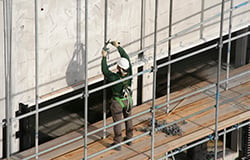 According to OSHA, approximately 2.3 million construction workers frequently work on scaffolds. Scaffold-related accidents cause about 4,500 injuries and 50 deaths every year. They also result in $90 million in lost workdays. Taking steps to ensure compliance with the scaffolding standards could help employers protect workers and prevent significant costs.
According to OSHA, approximately 2.3 million construction workers frequently work on scaffolds. Scaffold-related accidents cause about 4,500 injuries and 50 deaths every year. They also result in $90 million in lost workdays. Taking steps to ensure compliance with the scaffolding standards could help employers protect workers and prevent significant costs.
Additionally, the Bureau of Labor and Statistics reports 72% of workers injured in scaffold accidents attributed the accident to the planking or support giving way, or to the employee slipping or being struck by a falling object. These situations could be prevented with proper compliance with the OSHA standards.
Scaffolding is discussed in numerous standards including general industry, shipyard employment, marine terminals, and longshoring. But it is the construction scaffolding standard which generates a high number of violations each year. It is the 3rd most cited OSHA standard for 2014 with 4,029 violations.
What can you do to keep your employees safe while working on scaffolding?
Understand The Common Hazards Associated With Scaffolds
OSHA identifies the following as common scaffolding hazards:
- Falls from elevation, due to lack of fall protection;
- Collapse of the scaffold, caused by instability or overloading;
- Being struck by falling tools, work materials, or debris; and
- Electrocution, principally due to proximity of the scaffold to overhead power lines.
According to the Safety Business and Legal Resources site, most often the violations associated with the construction scaffolding standard stem from:
- Scaffolds that are not fully planked,
- A lack of portable or hook ladders to access scaffold platforms,
- Scaffolds loaded in excess of their capacity, and
- Failing to protect employees from fall hazards on scaffolds.
Understand The Standard And Its Requirements
To protect your workers, ensure you understand all the requirements of the standard. OSHA offers standard details on their website. They also offer an eTool to learn more about the standard. For additional resources, you can also visit the National Safety Stand-Down website. It is an awareness and education effort to help prevent fall hazards in construction.
Fall Protection
There are several ways fall protection can be implemented on scaffolds. The most common is a guardrail system. The personal fall arrest system is also used in situations that don't allow the use of guardrails.
Fall protection for scaffold systems is a bit different from provisions in the general fall protection standard. Each employee on a scaffold more than 10 feet above a lower level shall be protected from falling to that lower level. Additionally, there are specific types of fall protection to be provided to the employees on each type of scaffold.
Guardrail systems must meet the requirements of the fall protection standard: 42 inch rail, a mid rail, and 4 inch toe kick.
Crossbracing is acceptable in place of a mid rail when:
- The crossing point of two braces is between 20 inches and 30 inches above the work platform.
- As a top rail when the crossing point of two braces is between 38 inches and 48 inches above the work platform.
- The end points at each upright shall be no more than 48 inches apart.
Training
The employer should train each employee who performs work while on a scaffold. Training should be focused on teaching workers to recognize the hazards associated with the type of scaffold being used and to understand the procedures to control or minimize those hazards.
The training shall include the following areas, as applicable: use, care, storage, assembly, disassembly, and capacities. The nature of any electrical hazards and correct procedures to eliminate these hazards should be discussed. Fall protection systems should be discussed, developed, and implemented prior to work being started. All exposed employees should have a clear understanding of his or her responsibilities.
Retraining
When a competent person/supervisor has reason to believe that an employee lacks the skill or understanding needed for safe work involving the erection, use, or dismantling of scaffolds management should provide additional training until knowledge is demonstrated.
Retraining should also occur in the following circumstances:
- Where changes at the worksite present a hazard about which an employee has not been previously trained.
- Where changes in the types of scaffolds, fall protection, falling object protection, or other equipment present a hazard about which an employee has not been previously trained.
Spending time to understand the scaffolding standard, put in place proper fall protection, and implement training and retraining of employees can help ensure the safety of your workers while working on scaffolding.



